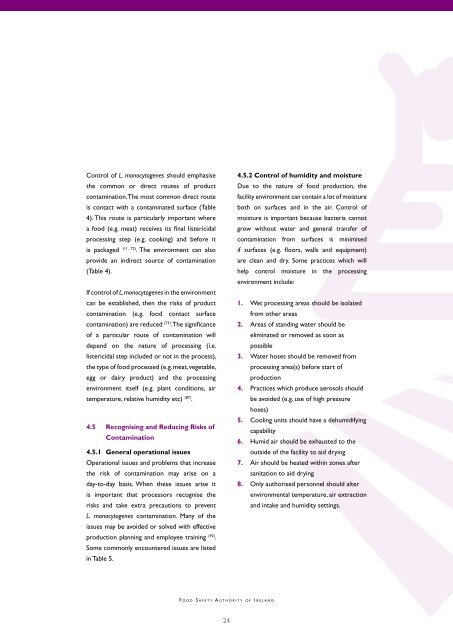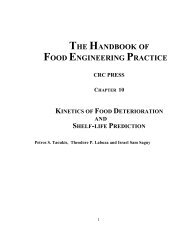Download - SMAS
Download - SMAS
Download - SMAS
- No tags were found...
Create successful ePaper yourself
Turn your PDF publications into a flip-book with our unique Google optimized e-Paper software.
Control of L. monocytogenes should emphasisethe common or direct routes of productcontamination. The most common direct routeis contact with a contaminated surface (Table4). This route is particularly important wherea food (e.g. meat) receives its final listericidalprocessing step (e.g. cooking) and before itis packaged (11, 72) . The environment can alsoprovide an indirect source of contamination(Table 4).If control of L. monocytogenes in the environmentcan be established, then the risks of productcontamination (e.g. food contact surfacecontamination) are reduced (73) . The significanceof a particular route of contamination willdepend on the nature of processing (i.e.listericidal step included or not in the process),the type of food processed (e.g. meat, vegetable,egg or dairy product) and the processingenvironment itself (e.g. plant conditions, airtemperature, relative humidity etc) (87) .4.5 Recognising and Reducing Risks ofContamination4.5.1 General operational issuesOperational issues and problems that increasethe risk of contamination may arise on aday-to-day basis. When these issues arise itis important that processors recognise therisks and take extra precautions to preventL. monocytogenes contamination. Many of theissues may be avoided or solved with effectiveproduction planning and employee training (92) .Some commonly encountered issues are listedin Table 5.4.5.2 Control of humidity and moistureDue to the nature of food production, thefacility environment can contain a lot of moistureboth on surfaces and in the air. Control ofmoisture is important because bacteria cannotgrow without water and general transfer ofcontamination from surfaces is minimisedif surfaces (e.g. floors, walls and equipment)are clean and dry. Some practices which willhelp control moisture in the processingenvironment include:1. Wet processing areas should be isolatedfrom other areas2. Areas of standing water should beeliminated or removed as soon aspossible3. Water hoses should be removed fromprocessing area(s) before start ofproduction4. Practices which produce aerosols shouldbe avoided (e.g. use of high pressurehoses)5. Cooling units should have a dehumidifyingcapability6. Humid air should be exhausted to theoutside of the facility to aid drying7. Air should be heated within zones aftersanitation to aid drying8. Only authorised personnel should alterenvironmental temperature, air extractionand intake and humidity settings.F O O D S A F E T Y A U T H O R I T Y O F I R E L A N D24














